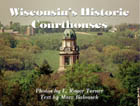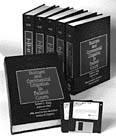Book Reviews
This Month's Featured Selections
 Wisconsin's Historic Courthouses
Wisconsin's Historic Courthouses
Marv Balousek & L. Roger Turner
(Oregon, WI: Badger Books Inc., 1998).
Hardcover. 140 pgs. Retail $35.
Reviewed by Stacey A. Carlson
This book takes us back in time to allow us a glimpse of early
Wisconsin life and politics. L. Roger Turner does a wonderful job of
photographing these historic monuments to accompany Marv Balousek's
research on the history of Wisconsin's county courthouses.
Wisconsin's Historic Courthouses is filled with photographs
of our state's architectural treasures and obscure but scandalous
details of towns pitted against one another in the struggle over where
to locate the county seats. The book emits a faint wisp of the
palm-greasing that surely was a necessary evil in acquiring at least
some of these magnificent structures.
While it is fast and interesting reading, this book is in need of
proofreading and editing. The book is arranged alphabetically by county,
with the result that time sequences are intermingled chronologically
causing the reader to constantly flip around to see where things were
when.
As L. Roger Turner's photographs show, styles of the courthouses
range from the elegant designs of the past to the stoic designs of the
modern day. From simple wooden structures to grandiose Italian styles,
the book provides a sample of the architectural tastes of the
period.
Marv Balousek has provided the reader with a time capsule account of
these magnificent courthouses, some of which exist only in photographs
today, and an extensive source appendix for further reading.
This book serves as a worthy archive treasure in any library and is
an excellent guidebook to touring our state treasures - Wisconsin's
historic courthouses.
Stacey A. Carlson is a legal
assistant with Universal Foods Corp., Milwaukee.
Business and Commercial Litigation in Federal
Courts

152 litigators
(Eagan, MN: West Group and
American Bar Association, 1998).
Six vols., 6,690 pgs., two disks of forms/jury charges.
$480, 15% ABA member discount.
To order, call (800) 328-9352.
Reviewed by Troy D. Thompson
In an impressive undertaking sponsored by the American Bar
Association's Litigation Section, the 152 authors of this six-volume,
nearly 7,000-page set have created an extensive resource for attorneys
practicing in federal courts. The bound set includes sections on
practice and procedure, substantive law, and tactics and techniques, and
will be useful to both seasoned federal litigators and attorneys with
only a modicum of trial experience before the federal bar.
The volumes contain chapters on 28 of the most common types of
commercial litigation in federal courts, including both substantive law
and litigation strategy in those types of actions. Each chapter is
practice-oriented and contains checklists, practice pointers, narrative
discussion of liability, defenses, and damages, as well as case
summaries, forms, jury charges, and other features that make the
information more accessible to the reader.
Although the publication includes sections on practice and procedure,
it is not a complete substitute to the seminal treatises by either
Wright and Miller or Moore. The publication should be used in tandem
with these resources as a necessary supplement. I find that the real
benefit of Business and Commercial Litigation in the Federal
Courts is conferred through its lengthy discussions on pleadings
tactics and discovery techniques. The authors go beyond the normal
rudimentary discussions and ultimately detail and set forth
sophisticated end-game strategies.
In addition to the six bound volumes, the set also includes forms and
jury instructions on two disks in WordPerfect format. Numerous sample
complaints, answers, and affirmative defenses, and a host of
instructions for various federal causes of action are included. Retainer
agreements and guidelines for investigators are among the other
miscellaneous, but practical, forms to be found. They are easily
accessed.
This publication lives up to its foreword, which promises "a goldmine
of insights and advice about the dynamics of commercial litigation and
how to apply expert lawyering skills and techniques to the specific case
at hand." Its authors, acclaimed as "distinguished federal judges and
the cream of the commercial litigation bar," have created a thorough,
well-organized, and very relevant text that will serve as an important
reference tool. Its subject matter will be equally applicable to many
actions pending in state court. I highly recommend this publication to
individuals of all experience and skill levels who practice before the
federal bar.
Troy D. Thompson, Marquette 1998, is
an associate at Di Renzo & Bomier, Neenah. He practices in general
litigation, personal injury, Worker's Compensation, and employment
law.
How to Build and Manage a Personal Injury
Practice
By K. William Gibson
(Chicago, IL: ABA Law Practice Management Section, 1998).
Paperback. 176 pgs. Retail $43.96.
Reviewed by John Kornak
I was a little skeptical that this 154-page book, including
appendices and index, could possibly deliver what it advertises. Upon
reading, I was surprised to find a concise, general guide for the novice
attorney. Let me emphasize "general" and "novice." While this book
offers a very general overview of some of the issues involved in a
successful P.I. practice, it falls short of its promise as a "how-to"
book.
The book is divided into eight substantive chapters, the topics of
which could each easily fill an entire book. An experienced P.I.
practitioner, Gibson offers helpful hints to those needing some
guidance, but only provides a thumbnail sketch of the important issues
facing the P.I. lawyer. More time needs to be spent on marketing and
managing the practice. Less time needs to be spent on choosing office
space and deciding whether to go solo or practice with a partner.
The appendices contain some helpful information for the novice
practitioner, such as forms for the initial client interview, and
samples of letters to clients, insurance companies, and doctors. Some of
the appendix information regarding marketing analysis and task
assignments appears to be little more than filler.
If your goal is to read a book that guides you on how to build and
manage a personal injury practice, reading this book is not a wise use
of your time and money. If you need a point to begin your research, this
book is a reasonable choice.
John A. Kornak, Valparaiso 1986, is
an associate at Salvi & Schostok P.C., Waukegan, Ill. Licensed to
practice in Illinois and Wisconsin, he currently limits his practice to
catastrophic personal injury.
Wisconsin
Lawyer
